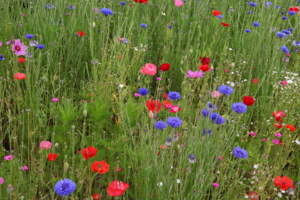
A meadow lawn is a lawn allowed to grow in the same way as a meadow,with a mixture of local grasses, wildflowers and introduced flowers. This type of "lawn" is only suitable for very large areas, as it is the large size of the lawn that produces its lovely appearance, due the sparse spread of the flowering plants. Most of the flowers only appear during the spring or summer season, so the rest of the year is usually only grass, something that may not appeal to all gardeners or observers. If you are growing such a lawn in a more confined space, you'll need to plan carefully by adding different plants and decorations to make the appearance more pleasing throughout the year.
The benefits of this type of "lawn" is that it attracts local wildlife, forms its own meadow ecosystem and helps to restore a part of the environment that is often removed when human habitation over cultivates an area. It can also be used when allowing certain parts of farmland or garden spaces to lay fallow.
Soil preparation[edit | edit source]
The soil must be thoroughly prepared before creating a meadow lawn. It is important to remove weeds and weed bulbs, to prevent competition with the grasses and flowers that you'll be planting.
Select an area where you intend to create the meadow lawn. This must be easy for you to work with, so if it's on a slope, be sure it is not too steep to work on.
Dig over the soil and allow it to rest after digging. Remove the weeds and any other unwanted items from the area.
Adding the seeds and seedlings[edit | edit source]
Select grass varieties that are native to your area and you know will grow well for your local conditions. These can be seed or seedlings, depending on what is available. For a wide area, broadcasting seeds or seed-bombing will prove easiest.
As well as the grasses, choose native wildflowers and some other suitable flowers such as poppies, cornflowers and cosmos. You can also choose herb plants and perennials that flower. When making your choices, do not choose any plants that are considered to be weeds or invasive and definitely don't use any that are banned.
If the meadow is to be mowed regularly, do not include bulb plants, as they will be killed if chopped off too often. Most bulbs can withstand two to three mowing cycles a year but no more.
Caring for a meadow lawn[edit | edit source]
A well-grown and balanced meadow lawn should find its own equilibrium and take care of itself for most of the year. It will develop its own ecosystem and this will help it to remain healthy. If you have the energy and patience, removal of any obvious weeds can be helpful; however, if the meadow lawn is well balanced, the weeds won't get a stranglehold but will be tolerated parts of the whole.
If you do mow or cut the lawn, follow the cycles of the plants––mow late summer, followed by a good watering and mow before bulbs appear. Set the mower/cutter blades to a high level setting or use hand tools and judge with your eyes what a good height is. You do not want to cut a meadow lawn down to the height of a typical suburban lawn!
Enjoying your meadow lawn[edit | edit source]
Appreciate the meadow lawn for what it is, a whole interconnected web of relationships that allow plants, animals and fungi to thrive without much (or indeed any) interference from you. You will be able to see it change through the different seasons, and come to love each aspect of its changes. The meadow lawn might inspire you over time to extend it and replace areas that otherwise require more hard work to keep perfectly manicured. You will also find that birds, mammals and insects appreciate the meadow lawn considerably.